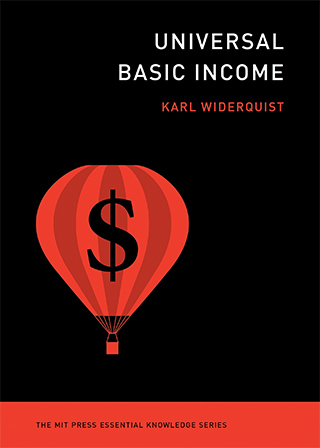The Deep and Enduring History of Universal Basic Income

Support for universal basic income (UBI) has grown so rapidly over the past few years that people might think the idea appeared out of nowhere. In fact, the idea has roots going back hundreds or even thousands of years, and activists have been floating similar ideas with gradually increasing frequency for more than a century.
Since 1900, the concept of a basic income guarantee (BIG) has experienced three distinct waves of support, each larger than the last. The first, from 1910 to 1940, was followed by a down period in the 1940s and 1950s. A second and larger wave of support happened in the 1960s and 1970s, followed by another lull in most countries through about 2010. BIG’s third, most international, and by far largest wave of support began to take off in the early 2010s, and it has increased every year since then.
Before the First Wave
We could trace the beginnings of UBI into prehistory, because many have observed that “prehistoric” (in the sense of nonliterate) societies had two ways of doing things that might be considered forms of unconditional income.

First, nomadic, hunting and gathering societies of less than 60 people have often been observed to treat all land as commons, meaning that everyone can forage on the land but no one can own it. A similar right to use land has existed in many small-scale agrarian communities right up to the enclosure movement, which was not complete in Europe until the 20th century and is not complete around the world today. The connection between common land and UBI is that both institutions allow every individual to have access to the resources they need to survive without conditions imposed by others.
Second, most observed small-scale, nomadic, hunter-gatherer societies had strong obligations to share what they had with others. If someone camping with the group found more food than they and their immediate family could eat in one meal, they had to share it with everyone in the camp, including people who rarely or never brought back food for the community. The food shared around camp could be seen as a “basic” income.
Some trace the beginning of UBI history to ancient Athens, which used revenue from a city-owned mine to support a small cash income for Athenian citizens.
The modern definition of UBI stipulates the grant must be in cash, and because small-scale hunter-gatherer or agrarian communities do not have cash economies, they do not have UBIs. But these practices show how the values that motivate much of the modern UBI movement are not new to politics but have been recognized and practiced for a very long time.
Some writers trace the beginning of UBI history to ancient Athens, which used revenue from a city-owned mine to support a small cash income for Athenian citizens. This institution sounds like a UBI, except that the meaning of citizen was very different in ancient Athens. Citizens were a small, elite portion of the population. Noncitizens, such as slaves, women, and free noncitizen males, were the bulk of the population and virtually all of its labor force. A UBI for the elite is no UBI at all.
Proposals that begin to fit the modern definition of UBI begin in the 1790s with two writers, Thomas Paine and Thomas Spence. Paine’s famous pamphlet “Agrarian Justice” argued that because private ownership of the land had deprived people of the right to hunt, gather, fish, or farm on their own accord, they were owed compensation out of taxes on land rents. He suggested this compensation should be paid in the form of a large cash grant at maturity plus a regular cash pension at retirement age. That amounts to a stakeholder grant plus a citizens pension: nearly, but not quite, a UBI.
From a similar starting point, Spence carried the argument through to a full UBI, calling for higher taxes on land and a regular, unconditional cash income for everyone. If anyone can be said to be the “inventor” of UBI, it is Thomas Spence, but his proposal remained obscure, and the idea had to be reinvented many times before it became widely known.
Joseph Charlier, a Belgian utopian socialist author, reinvented the idea of UBI in 1848, suggesting the socialization of rent, with the proceeds to be redistributed in the form of a UBI.
Henry George, a late 19th-century economist, set out to solve the problem of persistent poverty despite economic progress. He proposed taxing land value at the highest sustainable rate and using the proceeds for public purposes. At one point, he suggested that part of the proceeds could be distributed in cash to all citizens, but UBI was never a central part of his proposal.
BIG proposals remained sparse until the early 1900s.
The First Wave
By the early 20th century, enough people were discussing BIG to constitute its first wave — or at least its first ripple — of support. The idea was still new enough that most advocates had little knowledge of each other, and they all tended to give their versions of the program a different name.
In the United Kingdom, Bertrand Russell and Virginia Woolf both praised the idea in their writings without naming it. In 1918, Dennis and E. Mabel Milner started the short-lived State Bonus League, which briefly attempted to get a conversation started with pamphlets and other publications, including what was probably the first full-length book on UBI: Dennis Milner’s 1920 publication “Higher Production by a Bonus on National Output.”
Several economists and social policy analysts, especially in Britain, discussed UBI, often under the name social dividend, in the 1930s and early 1940s. These included James Meade (economist and later Nobel laureate), Juliet Rhys-Williams (writer and politician), Abba Lerner (economist), Oskar Lange (economist), and G. D. H. Cole (political theorist, economist, and historian). It was apparently Cole who coined the term basic Income in 1935, although that term did not become standard for more than 50 years.
Major C. H. Douglas (a British engineer) included UBI under the name national dividend in a wider package of proposed reforms he called social credit. His ideas were most prominent in Canada, where the Social Credit Party held power in two western provinces on and off between 1935 and 1991, but the party abandoned support for Douglas’s proposed dividend not long after it first took power.
In 1934, Louisiana senator Huey Long debuted a Basic Income plan he called Share Our Wealth. He seems to have come up with the idea on his own; there is no evidence that he was influenced by the ideas spreading around the United Kingdom in those years. Long’s plan might have served as the basis for a presidential run in 1936 had he not been assassinated in 1935.
Although some of these early advocates were highly respected people, they were unable to get any form of BIG onto the legislative agenda in this era. As World War II drew to a close, most Western democracies built up their welfare systems on a conditional model, typified by the British government’s famous Beveridge Report, which recommended fighting poverty, unemployment, and income inequality with a greatly expanded welfare system based on the conditional model. Discussion of BIG largely fell out of mainstream political discussion for nearly two decades.
The Second Wave
Discussion of BIG was kept alive between the first and second waves largely by economists who increasingly portrayed it as an interesting theoretical alternative to existing social policies.
During the second wave, the phrases income guarantee and guaranteed income were often used without indicating whether the guarantee was a negative income tax (NIT) or a UBI. When specified, it was most often an NIT. However, the second wave was extremely important in directing international attention toward the idea of creating a world in which everyone would have an income above poverty level.
The second wave took off in the early to mid-1960s, when at least three groups in the United States and Canada separately started promoting the idea at about the same time. First, feminists and welfare rights activists, including Martin Luther King Jr., mobilized people frustrated by inadequate and often demeaning conditional programs. The feminist and welfare rights movements for BIG were closely tied together because there was widespread belief that existing welfare programs were inadequate, punitive, and too closely tied to the belief that “typical” families were “headed” by a “male breadwinner” with a “housewife.” Feminists led a large grassroots effort to replace U.S. welfare programs with BIG, and it became an official demand of the British Women’s Liberation Movement by the 1970s.
Some futurists saw a guaranteed income as a way to protect workers from disruptions to the labor market caused by the computer revolution.
Second, futurists such as Robert Theobald and Buckminster Fuller saw a guaranteed income as a way to protect workers from disruptions to the labor market caused by the computer revolution. This effort foreshadowed the automation argument for UBI in the 2010s, but it dropped off considerably in the 1980s and 1990s.
Third, several Nobel Prize–winning economists — including James Tobin, James Meade, Herbert Simon, James Buchannan, and Milton Friedman — and many other prominent economists began arguing that a guaranteed income would represent a more effective approach to poverty than existing policies. To them, BIG would have been an attempt to simplify and streamline the welfare system while also making it more comprehensive. The interest from economists made BIG a hot topic among policy wonks in Washington and Ottawa.
The mainstream media started paying attention to NIT around the time Lyndon Johnson declared War on Poverty. Politicians and policy advisors began to take up the idea. The Canadian government released several favorable reports on guaranteed annual income in the 1970s. For a short time, many people saw some kind of BIG as inevitable and as the next step in social policy: a compromise that everyone could live with. People on the left viewed it as the final piece of the welfare system — a policy that would fill in the remaining cracks. Centrists, conservatives, and people from the burgeoning libertarian movement saw it as a way to make the social safety net more cost-effective and less intrusive.
In 1971, the U.S. House of Representatives overwhelmingly passed a bill introducing a watered-down version of NIT. It missed becoming law by only 10 votes in the Senate. The next year, presidential nominees from both major parties endorsed a variety of similar proposals: Richard Nixon supported the watered-down NIT, and George McGovern briefly proposed a genuine UBI. The similarity of the two nominees’ positions probably made BIG less of an issue in the campaign than it would have been if one of them had opposed it.
Although Nixon won the 1972 election, BIG never got another vote. It died partly because it had no groundswell of support outside the politically marginalized welfare rights movement. Its proponents in Congress made little effort to sell the proposal to the public at large. Many prominent guaranteed income supporters viewed Nixon’s version with skepticism, seeing it as too small with too many conditions to fit the model. In the absence of a wider movement for BIG, politicians paid little or no political cost for letting Nixon’s plan die and letting the idea fade from public discussion.
Although the second wave was most visible in the United States and Canada, the discussion spilled over into Europe, even as the second wave waned in North America. A high-level government report in France focused on NIT in 1973. At about the same time, James Meade and others managed to draw attention to the idea in the United Kingdom. In 1977, Politieke Pariji Radicalen, a small party in the Netherlands, became the first party with representation in parliament to endorse UBI. The next year, Niels I. Meyer’s book “Revolt from the Centre” launched a substantial wave of support in Denmark.
People often look back on the second wave of the BIG movement as a lost opportunity because no country introduced a full UBI or NIT, but the second wave had some major successes. The United States and Canada conducted the world’s first BIG implementation trials. The United States created or expanded several programs that can be seen as small steps in the direction of BIG, including food stamps, the EITC, and the Child Tax Credit. All these programs provide income supplements to low-income people. Although they have restrictions and conditions that UBI and NIT don’t, they represent steps toward BIG because they have fewer conditions than most traditional social policies and because they were proposed or expanded as compromise responses to the guaranteed income movement.
In 1982, the State of Alaska introduced the Permanent Fund Dividend (PFD). The PFD provides yearly dividends, varying usually between $1,000 and $2,000 per year to Alaska residents. Despite being very small, Alaska’s PFD is the closest program yet to meeting the Basic Income Earth Network’s definition of UBI — falling short only by requiring people to fill out a form to verify that they meet the residency requirement.
Not only did these policies help a lot of people, but their success also provides evidence that can help to push social programs slowly in the direction of universality. But by the late 1970s and early 1980s, politicians such as Ronald Reagan and Margaret Thatcher dramatically changed the conversation. They successfully vilified virtually all welfare recipients as frauds, no matter how well they might have satisfied programs’ need-based criteria. As a result, many people stopped talking about how to expand or improve the welfare system and started talking about whether and how much to cut it. In response, the left largely went on the defensive. Any suggestion that the existing system might be replaced by something better could at that time be seen as lending support to people who wanted to cut existing programs and replace them with nothing.
In 1980, the United States and Canada canceled the last of their implementation trials. Canada stopped analyzing the data that it had spent years and millions of dollars collecting. For the next 30 years, with a few notable exceptions, mainstream politics in most countries included virtually no discussion of BIG.
Between the Waves
The 1980s, 1990s, and 2000s were downtime for BIG in world politics, but there were significant exceptions, when proposals briefly gathered attention in one place or another. These exceptions and the growth of academic interest in UBI were extremely important to building what became the third wave of the BIG movement. In 1982, a British parliamentary committee considered a UBI proposal. National waves of support happened in the Netherlands, Denmark, and postapartheid South Africa at various times. But for the most part, discussion of UBI took place outside the political mainstream.
Proposals continued to come out in various circles, but they were more easily ignored in this period. For example, Leonard Greene, an aviation expert and successful entrepreneur, wrote two books and sponsored a demonstration project in which he gave a small UBI to several families, but he received little, if any, media response. When I had the pleasure of meeting him, he described his 10-year-old son’s reaction to UBI, “So what you’re saying is that income doesn’t have to start at zero.” I’ve used that phrase ever since.
As one 10-year-old put it, “So what you’re saying is that income doesn’t have to start at zero.”
One place the UBI discussion grew steadily in this period was in academic journals. In 1984, a group of Britons, led mostly by academics, formed the world’s first national UBI network, the Basic Income Research Group (now the Citizen’s Basic Income Trust). In 1986, a group of academic researchers established a group that was initially called the Basic Income European Network (BIEN). Philippe Van Parijs (a Belgian philosopher) and Guy Standing (a British economist) were the most active leaders of BIEN for the first 20 or 25 years of its existence.
From the founding of BIEN to the present, UBI, rather than NIT, has dominated the BIG movement. However, in the last few years, the NIT model has come back. In some countries, the BIG discussion is dominated by NIT, usually under other names, such as guaranteed income.
The academic debate grew substantially between the mid-1980s and the 2000s, especially in the fields of politics, philosophy, and sociology. By the mid-2000s, national groups existed in at least two dozen countries, including the United States, where the U.S. Basic Income Guarantee (USBIG) Network had been established in December 1999. Because so many UBI networks around the world wanted BIEN affiliation, the network changed its name to Basic Income Earth Network in 2004. Yet UBI stayed mostly outside the political mainstream.
I became interested in UBI as a high school student in 1980, just as the second wave of discussion was dying down. I started writing about it professionally after finishing graduate school in 1996, when the idea seemed hopelessly out of the mainstream. For those of us taking part in UBI events in the late 1990s and early 2000s, it felt less like a movement and more like a discussion group.
Even the activist contingent within BIEN and other networks concentrated more on discussion than action, believing (probably correctly) that they had to increase public awareness before they could gather the critical mass of support needed to make political action viable. Isolation from mainstream politics distracted supporters from how much their movement was growing. But as supporters would learn in retrospect, they were helping to lay the groundwork for a takeoff.
The Third Wave
Interest in UBI has grown enormously since 2010. The discussion crossed over into the mainstream international media by the mid-2010s. In some places, the crossover began earlier. Those of us who were volunteering at BIEN’s Basic Income News service noticed a substantial increase in media attention in late 2011 and early 2012, and media attention has grown steadily since. It is impossible to attribute the third wave of the UBI movement to any single source. It is the confluence of many widely dispersed actions and events, which I will try to sketch here as well as I can.
The financial meltdown of 2008, the subsequent Great Recession, and the Arab Spring sparked a new climate of activism. Public attention turned to poverty, unemployment, and inequality. UBI supporters suddenly had a much more welcoming environment for activism.
By 2008, a national wave of UBI support had begun to swell in Germany. Prominent people from across the political spectrum all began to push different UBI proposals in very public ways. That year, UBI activists in Germany, Switzerland, and Austria attracted the critical mass necessary for effective UBI activism and jointly organized the first International Basic Income Week. This event has taken place every year since and has spread around the world, now including actions as far away as Australia and South America.
In 2008, the Namibian Basic Income Grant Coalition, funded mostly by private donations from the Lutheran Church, began a two-year pilot, giving a small Basic Income to every resident of a rural Namibian village. This project coincided with a smaller one in Brazil and was followed by a much larger one in India in 2010 (both also largely or entirely funded by private donations). These trials attracted substantial media attention both locally and internationally. They helped inspire the privately and publicly funded experiments later conducted around the world.
Just as the Indian experiment faded from the headlines, European activists introduced UBI to the European mainstream media by pushing two citizens’ initiatives, one in Switzerland and one in the European Union, both of which attracted hundreds of thousands of signatures. The EU initiative recruited across Europe and collected signatures from every EU member state. The Swiss initiative collected enough signatures to trigger a national vote, which was held in 2015. Although neither initiative ultimately passed, they both built an infrastructure for UBI activism across Europe and attracted enormous international media attention, which in turn sparked additional activity and attracted more support.
At about this time, journalists around the world started paying attention to UBI, greatly increasing its visibility. By 2015, a third wave was visible to people who were paying attention, and all subsequent activism for UBI owes something to the cumulative results of the actions up to that point.
However, the chain of activism building on activism was only one of many sources of growth in the UBI movement. One of the movement’s most important strengths is its diversity: Support comes from many different places and from people who do not usually work together, follow similar strategies, or adhere to similar ideologies.
By the time the UBI experiment was underway in Namibia, economists and sociologists had already begun reassessing the results of the 1970s NIT experiments in the United States and Canada, bringing renewed press attention to BIG and helping to spark new interest in the idea.
Another source of momentum for UBI came from developing countries that had been streamlining and easing the conditions of eligibility for redistributive programs by creating what are now known as conditional cash transfers (CCTs). Although these programs were conditional, the results from easing conditions were so positive that they significantly bolstered support for further steps toward UBI, not only in lesser-developed countries of the Global South but all around the world. At least one CCT program, Brazil’s Bolsa Familia, inspired by the senator and UBI advocate Eduardo Suplicy, was introduced explicitly as a step toward UBI.
Support comes from many different places and from people who do not usually work together, follow similar strategies, or adhere to similar ideologies.
The third wave of the UBI movement is more identifiably left of center than the second wave, which involved many people who portrayed BIG as a compromise between left and right. But some right-of-center support has boosted the movement as well. For example, a group of philosophers and economists calling themselves Bleeding Heart Libertarians wrote a significant amount of pro-UBI literature in the 2010s.
Mirroring the futurism discourse of the 1960s, new attention to the automation of labor and the related precariousness of employment brought many new adherents to UBI. As unemployment reached new highs during the Great Recession and job openings lagged behind the overall economic recovery, many people, especially in high-tech industries in the United States, began to worry that the pace of automation was threatening large segments of the labor force with high unemployment, low wages, and gig-economy precariousness. Labor leaders, activists, academics, and tech entrepreneurs have all proposed UBI in response, making automation-related labor market changes one of the prime drivers of recent interest in UBI, especially in the United States. Some entrepreneurs, such as Chris Hughes of Facebook and the late Götz Werner of the German drugstore chain DM, have put their money where their mouth is, supporting UBI research, activism, and experimentation, giving an unquestionable boost to the movement.
Another way technology has affected the UBI debate is through cryptocurrencies (privately issued, all-electronic mediums of exchange). Some people see cryptocurrency as a way to bypass central banks entirely and provide users with a UBI in the newly created currency.
Environmentalism has also played a major role in the growth of interest in UBI. Two of the most popular proposals for combating climate change are the tax-and-dividend and cap-and-dividend strategies, both of which involve setting a price on carbon emissions and distributing the revenue to all citizens — thereby creating at least a small UBI. Some environmentalists see UBI as a way to counteract the depletion of resources by giving people a way out of the cycle of work and consumption. These kinds of proposals have received support from both Republicans and Democrats.
Growing interest in UBI, and to some extent tech industry money, have inspired a new round of UBI and UBI-related pilot projects in Finland, Kenya, Canada, the Netherlands, Germany, the United States, and many other places. UBI experiments are both a product and a driver of the current wave of support for UBI. This new round is characterized mostly by many small experiments rather than the few large experiments of the 1970s. Part of the reason is that many of the contemporary experiments are privately financed and therefore have to work on more limited budgets.
One exception is GiveDirectly’s enormous project in Kenya. This nonprofit has raised enough funds to finance a UBI of 75 cents per day for 20,000 people for 12 years, in an area where many people live on a dollar per day or less. When complete, this study will be the largest and longest UBI experiment ever conducted.
Between 2017 and 2020, UBI support got a large boost from Andrew Yang’s campaign for president of the United States. He was the first major-party candidate to endorse UBI since 1972, and the first ever to make UBI the centerpiece of their platform. For a political outsider, Yang did extremely well, qualifying for debates and recruiting a large network of supporters. Partly inspired by Yang, many candidates for lower offices also endorsed UBI in 2020 and 2022.
U.S. activism for UBI took off in October 2019, when activists in New York organized a UBI march from Harlem to the South Bronx. Hundreds of people, including myself, participated in the New York march, while 30 cities around the world joined in with their own marches. The march was so successful that organizers decided to make it an annual event. The 2022 march took place on September 24 at the climax of Basic Income Week.
Just as Yang suspended his campaign in 2020, UBI got yet another boost from an unexpected source. The COVID-19 outbreak and the related economic meltdown gave impetus for a temporary, emergency UBI. Suddenly mainstream politicians across the world were discussing UBI.
UBI was particularly well suited to the COVID situation. It functions as a cushion for people who are unable to work either because of social distancing or because of the economic downturn, and at the very same time it functions as a bonus for the essential workers asked to remain on the job during a pandemic. In both ways, it helps reduce the severity of the recession by stimulating the economy from the bottom up. To some extent, these policies represented politicians catching up with activists who had been calling for quantitative easing for the people (rather than for bankers) since the start of the Great Recession in 2009.
As late as perhaps 2015, it remained unclear whether the third wave would match the size and reach of the second. By 2019, the answer was obvious: Grassroots support and international media attention are more extensive than ever. The third wave represents the first truly global wave of UBI support. The first two did not extend much beyond the United States, Canada, and the United Kingdom, but the third wave involves major campaigns on all inhabited continents.
The Pattern
This look at the ups and downs of the UBI movement shows that UBI has tended to enter the mainstream conversation at times when people were concerned with and open to new approaches to address inequality, poverty, and unemployment. UBI has tended to recede from the mainstream conversation when public attention turned to other issues, or when other ways of addressing inequality became dominant. The first wave subsided when policymakers settled on the attempt to build a comprehensive welfare system on the conditional model. The second wave subsided (at least in the United States and Canada) not in the prosperous economy of the mid-1980s but in the troubling times of the late 1970s, when right-wing politicians convinced large numbers of people that redistributive programs should be cut instead of improved.
The biggest danger to the third wave appears to be growing nationalism. If nationalist politicians can convince enough voters to blame immigrants and foreign competition for growing inequality, they can effectively distract people from mobilizing around better social policies.
Karl Widerquist, a professor of philosophy at Georgetown University-Qatar who specializes in distributive justice, is the author of “Universal Basic Income,” from which this article is excerpted.
This article draws heavily on Widerquist’s essay “Three Waves of Basic Income Support,” published in “The Palgrave International Handbook of Basic Income,” edited by Malcolm Torry.



